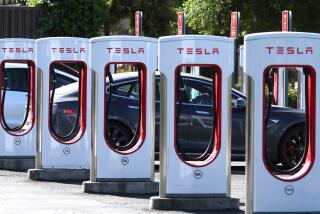How much would you pay for a self-driving car?
- Share via
Although the technology is just in its infancy, one in five drivers expresses interest in cars that drive themselves, reports research firm J.D. Power and Associates.
Tech giant Google Inc., Caltech and other organizations have been working to develop such “autonomous” vehicles, which use radar, video cameras and lasers to navigate roads and stay safe in traffic without human assistance.
Google has said that computer-controlled cars should eventually drive more safely than humans, who, after all, get sleepy and distracted and can’t see in every direction at once.
Some vehicle owners believe that one benefit of autonomous driving is taking control of a vehicle from careless and distracted drivers, the research firm said. So drivers could text as much as they want without endangering others.
But auto enthusiasts see autonomous driving as a “loss of status and would not want to give up the pleasure of driving,” J.D. Power said in its report, which surveyed 17,400 drivers in March.
“Consumers are still learning about how autonomous driving technology could be used in their vehicles,” said Mike VanNieuwkuyk, executive director of global automotive research at J.D. Power. “Many owners are skeptical about releasing control of their vehicle and would like to see the technology proved out before they adopt it.”
J.D. Power found that 20% of vehicle owners say they “definitely would” or “probably would” purchase it in their next vehicle after learning the estimated market price of $3,000. Before learning the price, interest for this technology was at 37%.
Men, drivers between the ages of 18 and 37 and people who live in urban areas were the most interested in fully autonomous driving, J.D. Power found.
Automakers are already offering autonomous driving functions in some vehicles.
Ford Motor Co. offers a park assist option that uses sensors on the front and rear of the vehicle to guide the vehicle into a parking space.
BMW has an “active” cruise control system that employs radar sensors at the front of the vehicle to scan the road ahead. When the car approaches a slower vehicle, the cruise control automatically reduces power and applies the brakes, holding the BMW at a pre-defined distance to the vehicle ahead.
Volvo has a low-speed collision avoidance system that will take control of the car’s brakes and stop the vehicle if it detects the vehicle is about to hit another car or object in front of it.
Google was in Detroit this week talking to automakers about autonomous vehicles.
Anthony Levandowski, who heads the company’s self-driving vehicle project, was looking to see how the technology can be adopted in vehicles either with automotive partners or as an aftermarket option.
He said the Google system still needs millions of miles of testing and that there are outstanding issues about liability in the event of crashes.
Legislation introduced earlier this year by California state Sen. Alex Padilla (D-Pacoima), SB1298, would establish guidelines for such “autonomous vehicles” to be tested and operated in California.
If approved, his legislation would direct the California Highway Patrol to develop standards and performance requirements for the safe testing and operation of autonomous vehicles on the state’s roads and highways.
In June, Nevada became the first state to legalize self-driving cars.
RELATED:
Ford brings electric car cost into focus
War veterans more likely to crash cars
Female drivers more likely to hit wrong pedal
More to Read
Inside the business of entertainment
The Wide Shot brings you news, analysis and insights on everything from streaming wars to production — and what it all means for the future.
You may occasionally receive promotional content from the Los Angeles Times.











